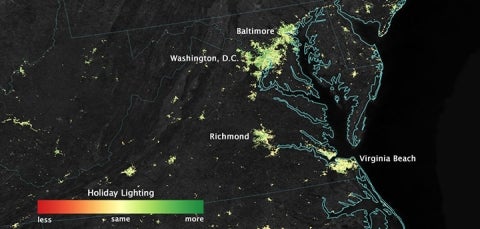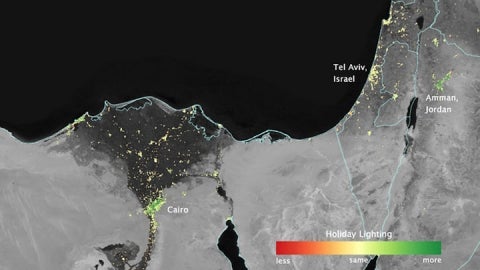Note: Yale School of the Environment (YSE) was formerly known as the Yale School of Forestry & Environmental Studies (F&ES). News articles and events posted prior to July 1, 2020 refer to the School's name at that time.
 In this satellite image of the Baltimore-Washington, D.C. area, dark green pixels indicate areas where lights were 50 percent brighter, or more, during the holiday season.
In this satellite image of the Baltimore-Washington, D.C. area, dark green pixels indicate areas where lights were 50 percent brighter, or more, during the holiday season.
New satellite observations reveal that changes in human behavior during holiday seasons — including bright Christmas light displays in the U.S. and a shift in activities during the holy month of Ramadan — are visible from space.
The study conducted by NASA and the National Oceanic and Atmospheric Administration (NOAA), and co-led by Eleanor Stokes, a Ph.D. candidate at the Yale School of Forestry & Environmental Studies, shows that light intensity increases by as much as 50 percent in some U.S. regions during the Christmas season.
In an analysis of light output from 70 cities during 2012 and 2013, they found that light intensity increased 30 to 50 percent between Thanksgiving and New Year’s Day in most suburbs and major city outskirts. Central urban areas were 20 to 30 percent brighter.
The researchers observed similar trends in Middle Eastern cities during the holy month of Ramadan, when people tend to push back social gatherings and meals until after daytime fasting. Those observations, however, varied from place to place depending on cultural and social dynamics of communities.
“The peaks that we observed are really ubiquitous and occur during the holidays,” said Stokes, a NASA Jenkins Graduate Fellow and Ph.D. candidate at F&ES. “[But] in the Middle East, we found a lot of variation between cities, with these lighting patterns tracking cultural variations.”
In some locations, including the Saudi Arabian cities of Riyadh and Jeddah, light usage increased by as much as 100 percent throughout the month. But in other regions there was little or no increase.
The study conducted by NASA and the National Oceanic and Atmospheric Administration (NOAA), and co-led by Eleanor Stokes, a Ph.D. candidate at the Yale School of Forestry & Environmental Studies, shows that light intensity increases by as much as 50 percent in some U.S. regions during the Christmas season.
In an analysis of light output from 70 cities during 2012 and 2013, they found that light intensity increased 30 to 50 percent between Thanksgiving and New Year’s Day in most suburbs and major city outskirts. Central urban areas were 20 to 30 percent brighter.
The researchers observed similar trends in Middle Eastern cities during the holy month of Ramadan, when people tend to push back social gatherings and meals until after daytime fasting. Those observations, however, varied from place to place depending on cultural and social dynamics of communities.
“The peaks that we observed are really ubiquitous and occur during the holidays,” said Stokes, a NASA Jenkins Graduate Fellow and Ph.D. candidate at F&ES. “[But] in the Middle East, we found a lot of variation between cities, with these lighting patterns tracking cultural variations.”
In some locations, including the Saudi Arabian cities of Riyadh and Jeddah, light usage increased by as much as 100 percent throughout the month. But in other regions there was little or no increase.
 The analysis showed that lights brightened in several Middle Eastern cities, including Cairo, during the Muslim holy month of Ramadan.
The analysis showed that lights brightened in several Middle Eastern cities, including Cairo, during the Muslim holy month of Ramadan.
In Cairo, the variations could be seen even at the neighborhood level, which corresponded with cultural or socioeconomic trends. For instance, in wealthier and more liberal districts, they found that light usage increased throughout the month. But in poorer, and more devout, neighborhoods, people tended to observe Ramadan without significant increases in light use until the Eid al-Fitr celebration that marks the end of the holiday.
“We saw that, at least during these short-term patterns, energy use is very connected to the cultural and social contexts in which someone lives,” Stokes said.
The data was collected by an instrument aboard the NOAA/NASA National Polar-orbiting Partnership (Suomi NPP) satellite capable of detecting the glow of cities and towns worldwide. Using an advanced algorithm developed by NASA’s Goddard Space Flight Center, researchers were able to filter out moonlight, clouds, and airborne particles.
The co-leader of the research was Miguel Román, a research physical scientist at NASA Goddard and member of the Suomi NPP Land Discipline Team.
The findings provide critical insights into how broad societal forces impact energy decisions, Stokes said. And with the UN Intergovernmental Panel on Climate Change (IPCC) suggesting that energy efficiency and conservation will play a key role in reducing greenhouse gas emissions, these insights have become increasingly important, she said.
“We saw that, at least during these short-term patterns, energy use is very connected to the cultural and social contexts in which someone lives,” Stokes said.
The data was collected by an instrument aboard the NOAA/NASA National Polar-orbiting Partnership (Suomi NPP) satellite capable of detecting the glow of cities and towns worldwide. Using an advanced algorithm developed by NASA’s Goddard Space Flight Center, researchers were able to filter out moonlight, clouds, and airborne particles.
The co-leader of the research was Miguel Román, a research physical scientist at NASA Goddard and member of the Suomi NPP Land Discipline Team.
The findings provide critical insights into how broad societal forces impact energy decisions, Stokes said. And with the UN Intergovernmental Panel on Climate Change (IPCC) suggesting that energy efficiency and conservation will play a key role in reducing greenhouse gas emissions, these insights have become increasingly important, she said.
– Kevin Dennehy kevin.dennehy@yale.edu 203 436-4842
Published
December 18, 2014